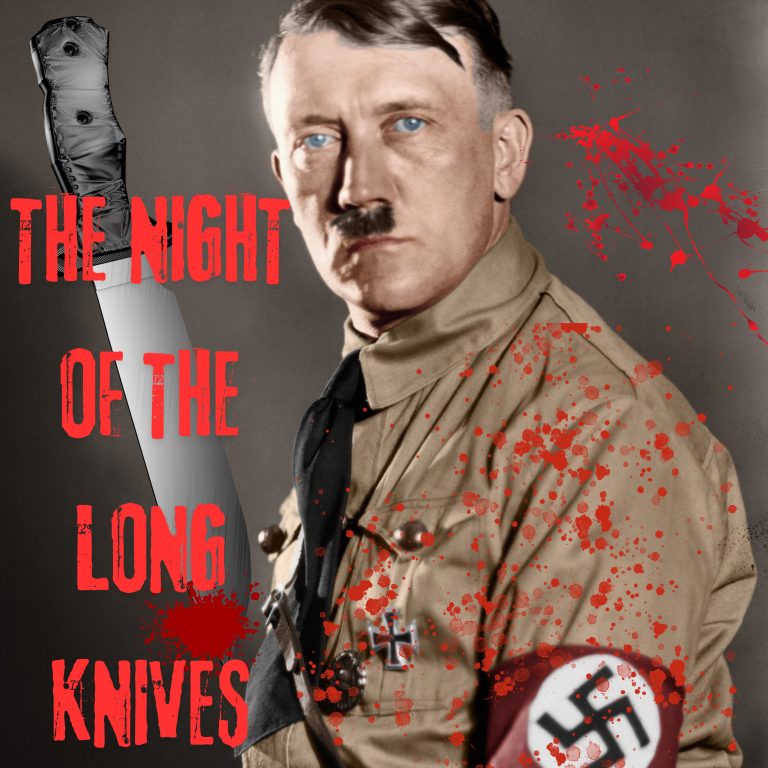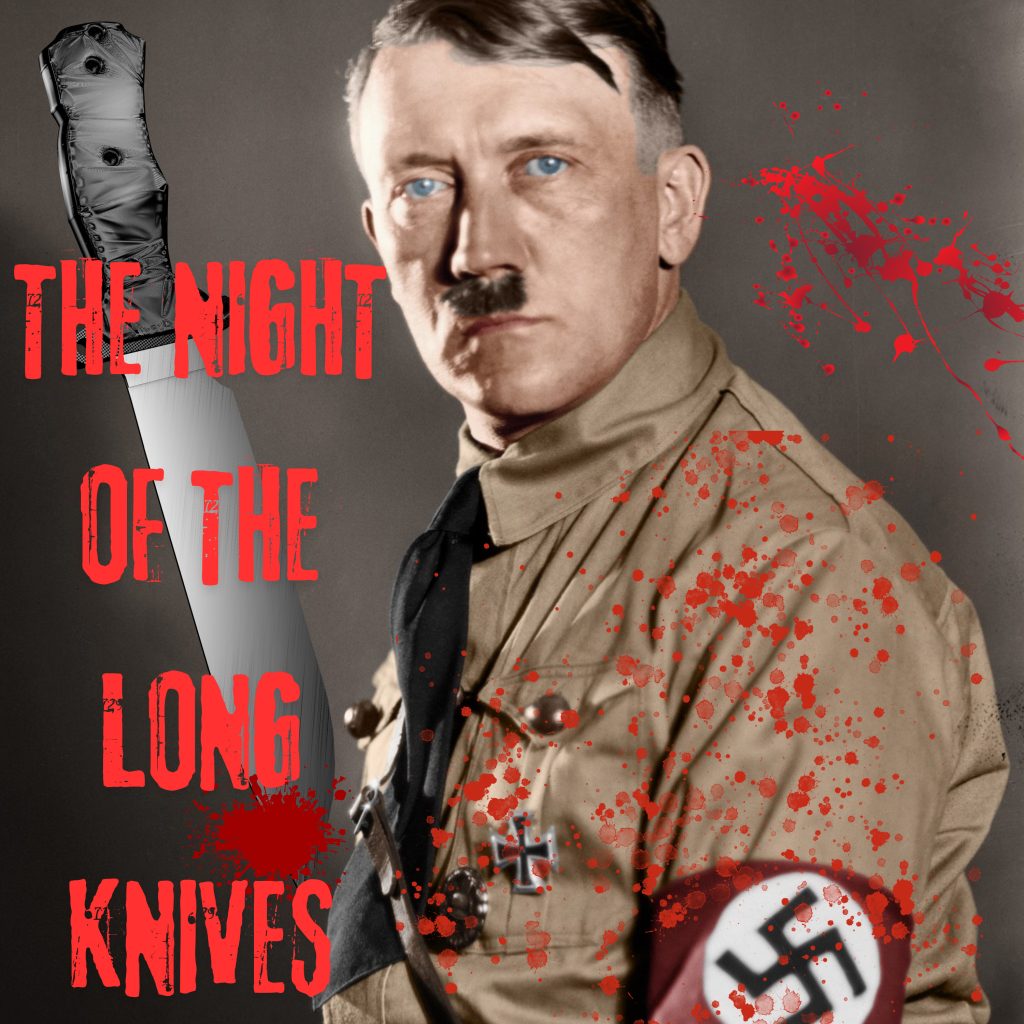
This show will get to the bottom of all those questions you need answers to. Each week, we will cover a topic that has been left unattended in the public square, with unanswered questions surrounding the “official story.” You will be able to determine on this show if the topic has been deemed a “Conspiracy” or a “Conspiracy Theory”.
If you want to support the show, you can become a subscriber and get access to bonus content. Click here to support https://creators.spotify.com/pod/profile/bottomofthat/subscribe
In the Summer of 1934 for 1 year and a half, Germans have been living under the thumb of Adolf Hilter. All it took was a few months for him to obliterate democracy and freedom of the press, and all civil liberties have been abolished. His opponents have been thrown in jail, the Nazi party has become the only party. Yet despite all the repression and violence, Hitler's power was still fragile he was torn between the 2 forces that brought him to power, on the one hand, the conservative tendency on the other the revolutionaries of the party he was under pressure and he's going to have to choose a side, he will do so in a decisive act of extreme brutality sacrificing the blood of some of his oldest companions among them his long time friend Ernst Röhm the other great figure of Nazism and the leader of the revolutionary tendency. It was a wave of assassinations that mark a turning point for Germany and turned it definitively into a Nazi dictatorship. So in the month of June 1934, an extraordinary criminal operation by the state is underway one that will last for 3 days and forever be remembered as The Night of the Long Knives.
Website – http://www.bottomofthat.com
Instagram – https://www.instagram.com/bottomofthat
Facebook – https://www.facebook.com/bottomofthat
X – https://twitter.com/bottomofthat
TikTok – https://www.tiktok.com/@bottomofthat
YouTube – https://www.youtube.com/channel/UCUI8xiBFWNntcMobz-_pbQQ
Rumble – https://rumble.com/c/c-1875987
Bitchute – https://www.bitchute.com/channel/TAIftfmNde4J
Email – truth@bottomofthat.com
#nightofthelongnives

In the Summer of 1934 for 1 year and a half, Germans have been living under the thumb of Adolf Hilter. All it took was a few months for him to obliterate democracy and freedom of the press, and all civil liberties have been abolished. His opponents have been thrown in jail, the Nazi party has become the only party. Yet despite all the repression and violence, Hitler’s power was still fragile he was torn between the 2 forces that brought him to power, on the one hand, the conservative tendency on the other the revolutionaries of the party he was under pressure and he’s going to have to choose a side, he will do so in a decisive act of extreme brutality sacrificing the blood of some of his oldest companions among them his long time friend Ernst Röhm the other great figure of Nazism and the leader of the revolutionary tendency. It was a wave of assassinations that mark a turning point for Germany and turned it definitively into a Nazi dictatorship. So in the month of June 1934, an extraordinary criminal operation by the state is underway one that will last for 3 days and forever be remembered as The Night of the Long Knives.

The Night of the Long Knives, also known as “Operation Hummingbird” or “Röhm Putsch,” took place in Nazi Germany from June 30 to July 2, 1934.
In the months leading up to the Night of the Long Knives, tensions had been escalating between the SA (Sturmabteilung), led by Ernst Röhm, and other key factions within the Nazi Party and the German military. The SA was a paramilitary wing of the Nazi Party, initially instrumental in Hitler’s rise to power, but by 1934, its role and power had become a point of contention.
Key Factors Leading to the Planning of the Purge:
- SA’s Growing Power and Radical Agenda: Ernst Röhm had expanded the SA to over 3 million men by 1934, and he sought more political power for the SA in the new regime. Röhm’s vision included the SA absorbing the German Army, making him a powerful figure potentially rivaling Hitler.
- Military’s Discontent: The German Army was alarmed by Röhm’s ambitions, viewing the SA as unruly and undisciplined. The army leadership, which was conservative and traditional, was essential for Hitler’s plans for Germany and could not be alienated.
- Political Stability: Hitler needed the support of the conservative elites, including industrialists and the military, to maintain and solidify his power. Röhm’s push for a “second revolution” to redistribute wealth and undertake more radical societal reforms threatened this delicate balance.
- Hitler’s Decision: Amidst growing pressure from his close advisors, including Heinrich Himmler (head of the SS) and Hermann Göring, and with the backing of key military leaders who demanded that Röhm be restrained, Hitler decided to act. The purge was planned as a decisive move to eliminate the threat posed by Röhm and the SA, thereby ensuring the allegiance of the army and reinforcing his absolute control over the Nazi Party and Germany.
- June 30, 1934:
- Morning: Adolf Hitler and other Nazi leaders gather at the Reich Chancellery in Berlin to discuss the removal of Ernst Röhm, leader of the Sturmabteilung (SA), and other perceived threats to Hitler’s power. The operation was timed to be sudden and swift to catch the SA leadership off guard.
- Afternoon: Hitler leaves for Bad Wiessee, Bad Wiessee is a small spa town located in southern Germany, on the western shore of the Tegernsee lake in Bavaria. It is known for its picturesque landscapes and healing mineral springs. The town is situated about 50 kilometers south-southeast of Munich its there where he personally confronts Röhm about his intentions to take control of the German Army (Wehrmacht) and to carry out a “second revolution. “Hitler arrived at the Hanselbauer Hotel in Bad Wiessee, where Ernst Röhm and other SA leaders were staying. Despite their past camaraderie, Hitler led a group of SS officers who stormed the hotel. Röhm and his top aides were arrested without resistance. It was a dramatic and personal betrayal as Röhm had been a close companion and early supporter of Hitler. Ernst Röhm was not publicly executed. After being arrested during the Night of the Long Knives on June 30, 1934, Röhm was held in prison for a few days.
- Evening: Hitler issues an order for the arrest of key SA leaders, including Röhm, and other political opponents. The Gestapo, under the command of Heinrich Himmler, begins to carry out the arrests. Other SS and Gestapo units rounded up SA leaders and various perceived adversaries throughout Germany. Key figures targeted included top SA officials and others who had fallen out of favor with the Nazi leadership.
- Expanding the Purge: While the initial focus was on the SA leadership, the scope quickly widened to include a variety of other opponents and political dissenters, such as Gregor Strasser, a former prominent Nazi who had fallen out with Hitler, and Kurt von Schleicher, the last Chancellor of Germany before Hitler.
The day after the initial arrests on June 30, 1934, the purge continued across Germany, with further actions occurring on July 1st.
- July 1, 1934:
- Early Morning: Arrests of SA leaders and other perceived threats continue across Germany.
- Throughout the Day: The SS and Gestapo conduct searches, arrests, and executions of hundreds of individuals associated with the SA and other rival factions, as well as political opponents and critics of the Nazi regime. Many are killed without trial.
- Hitler Addresses the Reichstag: Hitler delivers a speech to the Reichstag justifying the purge as necessary for national unity and the elimination of treasonous elements within the Nazi Party.
- July 2, 1934:
- Continuation of Purge: Arrests and executions continue, although the intensity of the violence begins to diminish.
- Ernst Röhm: After being arrested during the Night of the Long Knives on June 30, 1934, Röhm was held in prison for a few days. On July 2, 1934, he was given the option to commit suicide, but when he refused, he was killed by two SS officers in his cell
- Hitler Consolidates Power: With the elimination of Röhm and other potential rivals, Hitler solidifies his control over the German military and strengthens his authority within the Nazi Party.
During the Night of the Long Knives, the number of people executed is estimated to range from 85 to 200, though some estimates go as high as 1,000. Official records and reports from the time provide varying numbers, partly due to the secretive and chaotic nature of the purge. Most historians agree that at least 85 people were confirmed killed, including key members of the SA leadership and various other political figures who were considered threats
- Method of Execution: Many of the executions during the purge were carried out summarily by shooting, often in secluded areas or in the confines of prisons. In some cases, victims were taken to remote locations, lined up, and shot, while others were killed in their cells without any pretense of a trial.
- Personal Betrayals: The purge involved personal betrayals, as many of those targeted were former comrades and early supporters of the Nazi movement. The abruptness and betrayal by trusted allies added a particularly sinister aspect to the killings. Ernst Röhm, for instance, was arrested by Hitler himself, a man he had considered a close friend and ally.
- No Legal Recourse: The victims of the purge had no legal recourse or chance to defend themselves. The SS and Gestapo, who carried out the executions, acted as judge, jury, and executioner. The lack of any formal legal process and the direct action by paramilitary forces underlined the lawless nature of the purge.
- Broader Intimidation: The purge was not only about eliminating current threats but also served as a warning to anyone who might consider opposing Hitler in the future. The violent and public nature of some of the arrests and killings served to intimidate and consolidate absolute power.
- Aftermath and Fear: The bodies of those killed were often left in prominent places or returned to families in a state that made the cause of death unmistakable. This was a deliberate strategy to instill fear among Nazi Party members and the general population.
- Impact on Families: The families of those executed were often left in distress, with their fates uncertain. Many families were not informed about the circumstances of the deaths, and the stigma of having a family member labeled a traitor or an enemy of the state could have lasting repercussions.
Arrests and Murders
- Gregor Strasser:
- Once a prominent leader within the Nazi Party and a key rival of Hitler, Strasser had resigned from his political positions by 1934. Despite stepping back, he was seen as a threat due to his previous influence and left-wing leanings within the party.
- Strasser was arrested on June 30, 1934, and was executed by a shot to the head in his cell at the Gestapo headquarters in Berlin.
- Kurt von Schleicher:
- The former Chancellor of Germany who was succeeded by Hitler, von Schleicher was considered a potential threat due to his political connections and influence.
- He was assassinated on June 30, 1934, in his home. An SS squad shot him and his wife, who was also killed in the attack. This murder was part of the broader aim of eliminating any potential opposition from the old conservative establishment.
- Gustav Ritter von Kahr:
- Von Kahr was the Bavarian Prime Minister who thwarted Hitler’s Beer Hall Putsch in 1923. By 1934, although no longer in power, he was still viewed as a potential source of opposition.
- He was kidnapped and brutally murdered; his body was found mutilated in a forest near Dachau, showing the extreme lengths to which the purge went to instill fear and remove any vestiges of resistance.
- Ferdinand von Bredow:
- A major general in the army, von Bredow had ties to Kurt von Schleicher and was considered part of the conservative military establishment that could oppose Hitler’s plans.
- He was arrested on the night of June 30 and shot the following day.
- Karl Ernst:
- A leader of the SA in Berlin and a member of the Reichstag, Ernst was also among those seen as a threat due to his power within the SA.
- While on his honeymoon, he was arrested, flown back to Berlin, and shot without trial.
- Edgar Julius Jung: A prominent conservative and speechwriter for Vice-Chancellor Franz von Papen, Jung was an outspoken critic of the Nazi regime. He was seen as an intellectual force behind the conservative opposition. Jung was arrested and shot, and his body was found dumped in a ditch.
- Erich Klausener: The head of the Catholic Action group, Klausener was a vocal critic of the Nazi regime’s interference in religious affairs. He was murdered in his office immediately following a speech he had given that was critical of the regime’s oppressive tactics.
- Fritz Gerlich: A journalist and editor, Gerlich was a staunch opponent of Hitler and had used his writings to attack the future dictator’s policies and personal life. He was arrested and later killed; his exact fate was not clear immediately, but he was believed to have been sent to a concentration camp and executed.
- Theodor von Duesterberg: The co-leader of the Stahlhelm, a nationalist veterans’ group, von Duesterberg had run against Hindenburg in the 1932 presidential elections. Though not killed, he was arrested during the purge and briefly imprisoned, which effectively ended his political influence.
After the Night of the Long Knives, Hitler emerged as the undisputed leader of Germany, having eliminated internal opposition and consolidated power in his hands. The event marked a significant turning point in the consolidation of the Nazi dictatorship and the establishment of Hitler’s totalitarian regime.
What is the difference between military and paramilitary?
The difference between military and paramilitary is that the line of work of the Military Forces is to safeguard the country from all types of external hazards, while the Paramilitary Force is charged with the work of guarding the residents of the country against internal brutality, ethical riots etc.
SS Germany” typically refers to the period in Nazi Germany when the Schutzstaffel (SS), originally established as a paramilitary organization within the Nazi Party, gained significant power and influence. Here’s a breakdown:
- Schutzstaffel (SS): The SS began as a small unit of Hitler’s personal bodyguards. Under the leadership of Heinrich Himmler, it expanded into a vast organization with multiple branches responsible for various aspects of Nazi Germany’s security, intelligence, and racial policies.
- SS Functions: The SS was involved in a wide range of activities, including policing, surveillance, intelligence gathering, and the administration of concentration camps. They also played a key role in implementing the Nazi regime’s racial policies, including the persecution and extermination of Jews and other targeted groups during the Holocaust.
- Expansion of Power: Over time, the SS grew to become a powerful and influential force within Nazi Germany, often rivaling or overshadowing other institutions such as the regular police and military. It operated independently of traditional state structures, answering directly to Hitler and Heinrich Himmler.
- Totalitarian Control: The rise of the SS marked a significant shift towards totalitarianism within Nazi Germany, as it exerted control over many aspects of civilian life and played a central role in enforcing Nazi ideology and suppressing dissent.
In summary, “SS Germany” refers to the period in Nazi history when the Schutzstaffel wielded immense power and influence, playing a key role in the implementation of Nazi policies and the establishment of a totalitarian regime under Adolf Hitler.
“SA Germany” refers to the period in Nazi Germany when the Sturmabteilung (SA), also known as the Storm Detachment or Brownshirts, held significant influence and played a prominent role in the Nazi movement. Here’s an overview:
- Sturmabteilung (SA): The SA was founded in 1921 as a paramilitary organization tasked with providing protection for Nazi Party meetings and disrupting the gatherings of political opponents. Under the leadership of Ernst Röhm, the SA grew rapidly, attracting many disaffected veterans and unemployed individuals during the economic turmoil of the Weimar Republic.
- Functions: Initially, the SA served as the primary instrument of Nazi Party intimidation and violence, engaging in street battles with political opponents and orchestrating acts of political terror. It also played a crucial role in the early stages of Hitler’s rise to power by providing muscle for the Nazi Party’s propaganda and recruitment efforts.
- Decline: Despite its early prominence, the SA’s power began to wane after Hitler became Chancellor in 1933. The organization became increasingly disorganized and undisciplined, leading to tensions within the Nazi regime. Additionally, Hitler saw the SA as a potential threat to his authority and sought to diminish its influence.
- Night of the Long Knives: In June 1934, Hitler ordered a purge of the SA leadership, known as the Night of the Long Knives, during which many SA leaders, including Ernst Röhm, were arrested and executed. This event marked the decline of the SA’s influence and the ascendance of the Schutzstaffel (SS) under Heinrich Himmler.
- Aftermath: Following the Night of the Long Knives, the SA was reorganized and its power significantly diminished. It continued to exist as a paramilitary organization but played a much-reduced role in Nazi Germany compared to its pre-1934 prominence.
In summary, “SA Germany” refers to the period in Nazi history when the Sturmabteilung held significant influence and played a central role in the Nazi Party’s rise to power, before its subsequent decline in the mid-1930s.
Ernst Röhm is the head of the SA the assault section the Nazi party’s paramilitary group that helped seize power above all he was one of Hitler’s first brothers in arms and he’s one of his few close friends but today he opposes Hitler head-on he’s not content just to be in power he wants to continue the great National Socialist Revolution.


